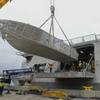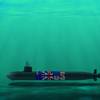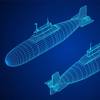The high-speed vessel (HSV 2) Swift is moored pier-side at Naval Amphibious Base Little Creek before departing for the western coast of Africa. While in Africa, Swift will take part in the Global Fleet Station (GFS), Africa Partnership Station (APS) Initiative, for the purpose of strengthening cooperative partnerships with regional maritime security. U.S. Navy photo by Mass Communication Specialist 3rd Class Tyler Jones
By Mass Communication Specialist 2nd Class (SW/AW) Elizabeth Merriam, Africa Partnership Station Public Affairs
Sailors aboard High Speed Vessel (HSV) 2 Swift repaired a Pilot Research Moored Array in the Atlantic (PIRATA) buoy, Jan. 25, as part of an ongoing effort of Africa Partnership Station (APS) to support the National Oceanic and Atmospheric Administration (NOAA) and its programs to collect environmental readings in the Gulf of Guinea.
Information collected by the buoys helps determine ocean-atmosphere interactions in the tropical Atlantic and Gulf of Guinea, an area that spawns hurricanes and adverse weather that affects not only the African continent, but the U.S. and Caribbean as well.
The buoys are normally serviced annually by NOAA or partner organizations in France and Brazil who share in the mission of studying the ocean, according to H. Paul Freitag, project manager Tropical Moored Buoy Project at NOAA's Pacific Marine Environmental Laboratory (PMEL).
"Working with the Navy gives us the advantage of repairing some systems between the regularly scheduled maintenance cruises which will improve the quality and quantity of data obtained," said Freitag.
Heading up the repairs on Swift was Mineman 2nd Class (SW) Matthew Rishovd, a Swift (Blue) crew member who received pre-deployment training from PMEL on how to repair the buoys and the importance they hold for the environment.
"Until I became involved in this I didn't have any idea what kind of influence buoys had on the environment and the relations between the different countries, the scientist and everybody. It's a lot larger than I could ever imagine," Rishovd said.
During Swift's mission in Africa, PMEL has kept in close contact with the ship, providing up-to-date information on which buoys are in the area and what repairs they may need.
"They sent me a sheet with the readings and sensors that needed to be replaced. When we pulled up on the buoy, I could see that it had been hit by a ship," said Rishovd, who repaired the buoy in about 45 minutes.
"While still in its initial stages, collaboration between NOAA and APS (or other Navy programs with similar goals) has the potential to further the aims of both agencies and their stakeholders," Freitag said. "Potential benefits to NOAA include better and more complete data and higher visibility of observing systems to governmental, commercial and academic agencies within the region. Benefits to APS include the potential for first hand interaction with advanced technology within the context of an internationally supported ocean observing system."
During APS, Swift is supporting several other APS initiatives in partnership with NOAA. These include serving as a training venue for the National Marine Fisheries Service and its fisheries observer course for Ghana's Fisheries Ministry, as well as deploying surface drifting buoys in the Gulf of Guinea on behalf of the Atlantic Oceanographic and Meteorological Laboratory.
Sponsored Content
LR - Fit for 55: Managing compliance and optimising operations

Use Roxtec seals, services and software

Subscribe for
Maritime Reporter E-News
Maritime Reporter E-News is the maritime industry's largest circulation and most authoritative ENews Service, delivered to your Email five times per week









